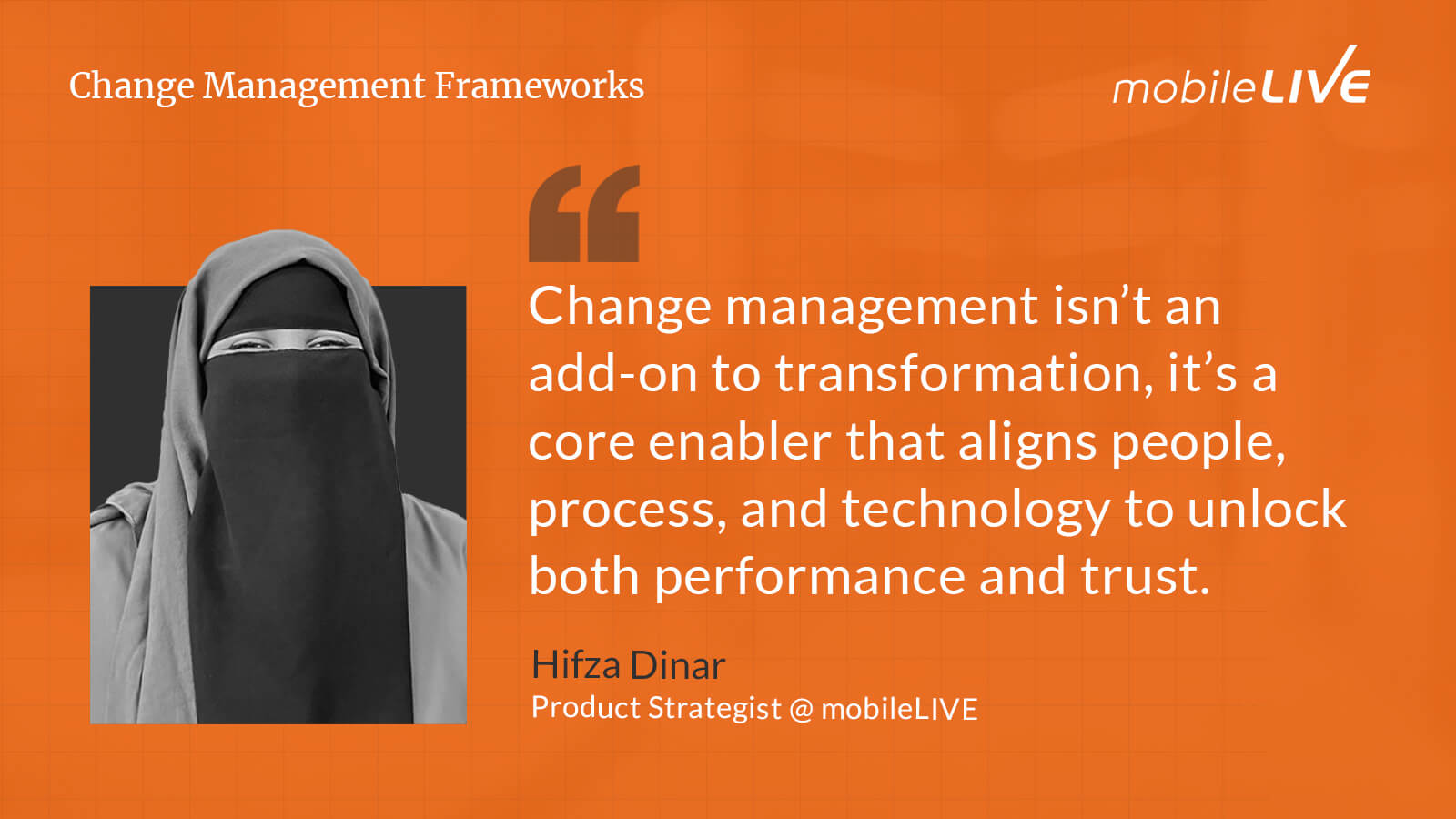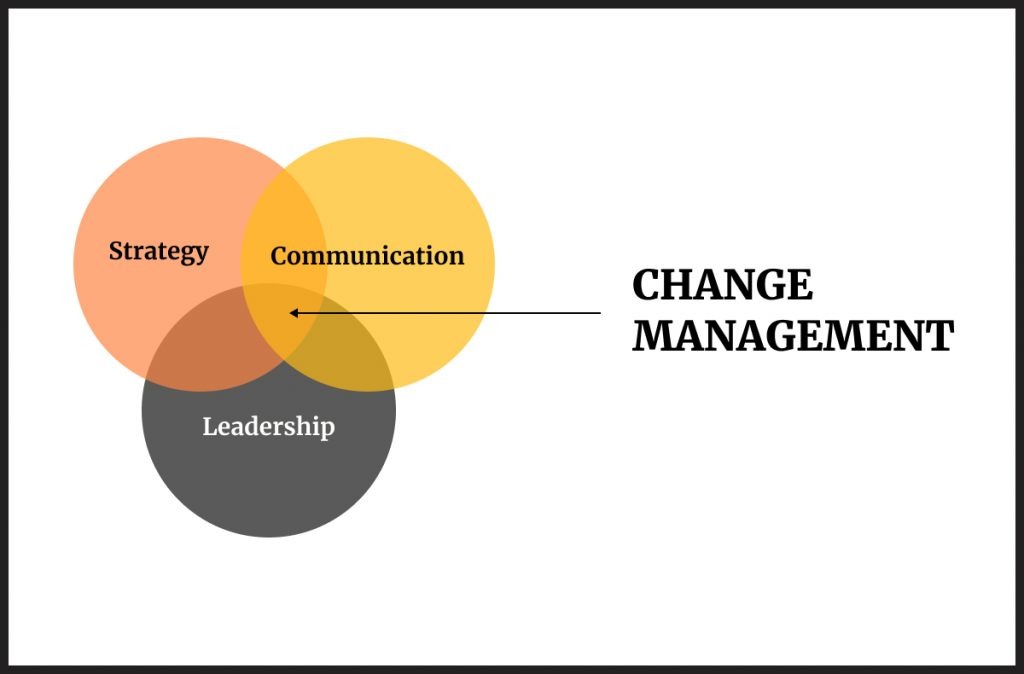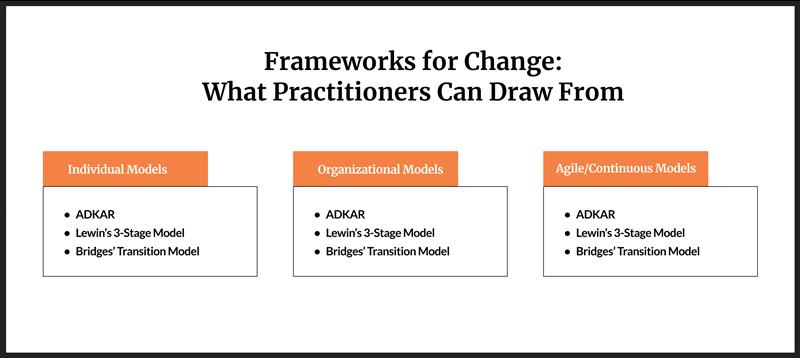
Jump To Section
Digital transformation has become a strategic necessity across industries. From banks modernizing customer experiences to manufacturers digitizing operations, organizations are under constant pressure to evolve. The investment is staggering, with global spending on digital transformation technology and services expected to reach $3.9 trillion by 2027 (BCG).
And yet, the reality remains sobering: 70% of digital transformations fail to achieve their intended goals (as per BCG). The problem rarely lies in the technology itself. Solutions are built, systems are deployed, and integrations are completed. What derails outcomes is the failure to bring people along with the change.
In fact, a McKinsey research shows that organizations with strong change management realize 143% of their expected ROI, compared to only 35% with weak or inconsistent practices. The lesson is clear: technology may be the engine, but change management is the fuel. Without it, even the most advanced initiatives stall.
Change management isn’t an add-on to transformation, it’s a core enabler. When done well, it aligns people, process, and technology in ways that unlock both performance and trust.

The People Side of Transformation
Organizations often focus on technical execution; deploying new platforms, reimagining workflows, automating processes, but underestimate how deeply change disrupts the daily experience of individuals. Employees may feel overwhelmed, resistant, or skeptical. Customers may feel blindsided. Leaders may underestimate the emotional and cultural impact of shifting “the way we’ve always done things.”
Consider the following scenarios:
Enterprise Software Rollout
When a multinational bank transitions its workforce to a new enterprise CRM, the technology itself isn’t the challenge. The real friction comes when employees resist abandoning old workflows, fear productivity dips, or don’t understand how the new system benefits them. Without structured change management, adoption lags, morale suffers, and ROI shrinks.
ERP Implementations
Large-scale ERP implementations are notorious for overruns and resistance. The platforms themselves are often robust, but if employees don’t see the purpose, lack training, or feel excluded from the process, projects stall. Most ERP “failures” stem not from the code but from inadequate preparation for human adoption.
Agile or DevOps Transitions
Shifting from traditional project management to Agile or DevOps promises speed and flexibility—but it also demands a cultural leap. Without engaging teams in new mindsets, rituals, and responsibilities, organizations risk creating confusion instead of agility.
Find a detailed look into an agile transformation strategy that keeps people at the centre here.
The data reinforces these lived realities: 73% of change-affected employees report experiencing moderate to high stress levels, and those suffering from change-related stress perform 5% worse than the average employee. Communications leaders themselves cite managing change fatigue as their top mission-critical priority (Gartner).
In all cases, the difference between frustration and adoption is the presence of structured change management.
Frameworks for Change: What Practitioners Can Draw From

Consulting firms and practitioners often lean on established models to guide transformation. While no framework is one-size-fits-all, each provides valuable lenses for addressing different scales of change.
1. Kotter’s 8-Step Model
John Kotter’s framework remains one of the most widely recognized approaches to organizational change. It emphasizes creating urgency, building guiding coalitions, forming a strategic vision, and embedding change into culture. Its strength lies in mobilizing momentum at scale.
2. McKinsey’s 7-S Framework
McKinsey highlights that successful transformation depends on alignment across seven interconnected dimensions: strategy, structure, systems, shared values, style, staff, and skills. It’s particularly effective in diagnosing organizational readiness and identifying gaps that could derail change.
3. Kaizen
Rooted in Japanese management philosophy, Kaizen focuses on small, continuous improvements. While often applied in manufacturing, it is increasingly relevant in digital transformations where iterative change and feedback loops ensure sustained progress.
4. Prosci PCT Model (Organizational Level)
Prosci’s Project Change Triangle (PCT) stresses that success depends on three forces working together:
- Leadership/Sponsorship – visible commitment from executives.
- Project Management – disciplined execution of the technical side.
- Change Management – ensuring people adopt and sustain the change.
If one element falters, success is at risk.
5. Prosci ADKAR Model (Individual Level)
ADKAR addresses the human journey of change at an individual level:
- Awareness of the need for change
- Desire to participate and support
- Knowledge of how to change
- Ability to implement new skills or behaviors
- Reinforcement to sustain the change
Its central principle is that organizational success is the sum of individual success. Without individual adoption, transformation outcomes never materialize.
While Kotter, McKinsey, and Kaizen provide organizational insights, Prosci’s combination of organizational (PCT) and individual (ADKAR) frameworks creates a holistic bridge.
Case Study: Managing Change with Empathy and Structure
One of Canada’s leading lighting manufacturers partnered with our team to support a digital transformation initiative. The company had been in business for over 50 years, and many employees were wary of new change efforts due to prior initiatives introduced abruptly, with little time to adapt.
Our challenge was not purely technical; it was cultural and human. Using the ADKAR model, we:
- Built Awareness through transparent communication and leadership sponsorship.
- Created Desire by showing teams the tangible benefits of transformation outcomes.
- Enhanced Knowledge with training and support materials.
- Enabled Ability through hands-on guidance in adopting new processes.
- Reinforced the change by celebrating milestones and embedding support mechanisms.
The results were significant:
- Teams that began hesitant became active contributors in scoping sessions.
- Shared ownership of the transformation replaced resistance.
- Trust in the transformation process and in the consulting partnership grew.
This case reinforced a core truth: when change is managed with empathy and structure, adoption accelerates, and outcomes stick.
3 Emerging Trends Defining the Future of Change Management
As organizations continue to navigate disruption, the discipline of change management is shifting from a support function to a strategic capability. The lessons of past transformations show that adoption and resilience can’t be left to chance. Looking ahead, three emerging trends will redefine how organizations approach change at scale.
AI-Enabled Personalization
The practical future of AI in change management lies in tailoring experiences. Tools will deliver role-specific communications, adaptive learning modules, and context-aware nudges, ensuring employees receive the right support at the right time. This shifts change management from one-size-fits-all to personalized and scalable.
Employee Experience at the Core
Change initiatives will increasingly be judged not only by business outcomes but also by their impact on employee well-being. Managing change fatigue, creating meaningful involvement, and supporting resilience will become central to how organizations design transformation journeys.
Data-Driven Change Metrics
Organizations will measure adoption, stress, and engagement with the same rigor as financial KPIs. Real-time feedback loops and analytics will allow leaders to see where adoption is strong, where resistance is building, and where additional interventions are required.
As transformation becomes a constant rather than an exception, change management will evolve from a project discipline to a core organizational capability.
Final Takeaways: The Way Forward
Digital transformation pays off only when behaviour changes at scale. Technology is the enabler, but adoption is the outcome that moves the sponsor’s KPIs. The most reliable path is to run change like a product: define the few outcomes that matter, segment by role, design enablement in the flow of work, and hold a steady cadence that measures and improves week over week.
The frameworks are well known; what differentiates results is how you apply them. Prosci’s PCT keeps leadership, delivery, and change management aligned at the organisational level, while ADKAR turns individual adoption into sprint-level acceptance criteria. Fold both into Agile delivery so every increment ships with the communications, job aids, and reinforcement needed for real work to be done the new way.
Context matters. Banking advisors, insurance adjusters, field technicians in telecom, and retail associates do different jobs under different constraints. Treat each audience with specificity and sequence change to avoid overload. Use AI where it helps—sentiment signals, role-based nudges, adaptive learning—but anchor it in clear governance: an executive sponsor, a product owner for change, an analytics lead, and an enablement lead who own the adoption scorecard together.
If you take one thing forward, make it this: declare “done” only when people can perform the critical tasks confidently and the business indicators have moved, not when the system goes live. That mindset turns transformation from a launch event into a managed, measurable shift in how your organisation creates value.
Ready to operationalise this? Start with a lightweight Change-by-Design assessment of your next release, stand up the adoption dashboard before go-live, and prove one role’s behaviour change end to end. Momentum, and credibility, will follow.



